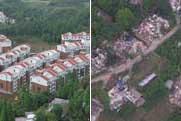China
China publishes evidences of Dalai clique´s masterminding of riots
RIOTERS' CONNECTIONS TO DALAI CLIQUE
The Ministry of Public Security revealed sufficient evidence on Tuesday that showed that the March 14 Lhasa violence was part of the "Tibetan People's Uprising Movement" plotted by the Dalai Lama clique.
Police officers have also found copies of a "Declaration of Tibetan People's Uprising Movement"; copies of the Dalai Lama's speech on March 10; pictures of the clique's members undertaking secessionist activities and computers used to contact officials of the clique's "government in exile" in the residence of a person who allegedly took place in the riots.
The suspect was arrested on March 15 of charges of accepting the clique's orders and undertaking secessionist activities, including beating, smashing, looting and arson, in Lhasa on March 14.
Evidence showed that the suspect was a core member of the rioters who have been connected to the Dalai clique since November2006 with the goal of carrying out the following activities:
-- The suspect cultivated 12 intelligence agents and established a tight underground intelligence network in Tibet to conduct secessionist activities, prompted by the official from the "security ministry" of the Dalai clique.
-- The agents used code words to contact each other in the intelligence network, such as calling the Dalai Lama "Uncle" and the Tibetan flag a "skirt", with clergy smuggled into Tibet being called "guests".
-- The suspect transmitted information 36 times to an official of the clique via the Internet. The information that he had collected from March 2007 to March 2008 domestically included domestic clerics' so-called "rejection of criticism of the Dalai Lama," and the so-called "killing of wild animals and ecological destruction" in Tibet.
-- The suspect also received information about the Dalai Lama's activities from the Dalai clique, produced disks and distributed these in Tibet.
The ministry revealed that the suspect and his intelligence network also spread propaganda supporting the Dalai clique and disputing China's religious policies in Tibetan monasteries.
After the Lhasa riot on March 14, agents in Tibet and officials of the clique had more frequent contacts. The official sent the "Declaration of Tibetan People's Uprising Movement" to the suspect, who later made copies of it and distributed it in Lhasa. The suspect also mobilized agents in the intelligence network to collect information and report to the Dalai clique.
The suspect who directly organized and participated in the Lhasa riot on March 14 has confessed to all of the accusations above.
Police officers have also arrested several persons who were suspected of participating in the riot. Preliminary police investigations found the proof of these activities and communication between the suspects and officials of the Dalai clique.
The suspect, Ngagwang Namgyi, admitted that he has undertaken secessionist activities for nearly 20 years. Ngagwang Namgyi was legally punished in 1989 as a monk in Lhasa's Zhebung Monastery for participating in a riot in the capital of the Tibet Autonomous Region that year.
"I owned five groceries in Doilungdeqen (a county on the outskirts of Lhasa) and six of the employees have criminal records. We have undertaken secessionist activities," said Ngagwang Namgyi, against whom testimony was given by other suspects.
The police have found that the Internet became an important channel for the Dalai clique to release its orders, many parts of the "Declaration of Tibetan People's Uprising Movement" and action plans.
The Dalai clique has found new ways to contact secessionists in Tibet. they would make appointments through telephone and Internet. At the appointed time, they would listen to Tiebtan language programs on the Voice of America, through which they convey instructions from overseas and report latest development inside China.
To spread the impact of the riots, backbones of the Dalai clique stole into China to spread rumor. They paid people to take part in the rioting and even had a policy of "more job, more pay".
"About 50 of us smashed several stores in Xuexin village on the afternoon of March 15, and I got paid several hundreds of yuan," said Zhoi'ma, from the Nyingchi prefecture of Tibet.
Garze Tibetan Autonomous Prefecture in Sichuan province is regarded by the Dalai clique as a "model area" for secessionist activities.
Since the outbreak of violence, overseas separatist forces had frequently called local contacts in Garze, urging them to "make things bigger."
Overseas separatists have been trying hard disseminate reactionary books, discs and pictures in Garze recently.
Since mid-February, Chengdu Customs had seized large quantities of materials advocating the independence of Tibet, brought in from India to local monasteries and villages.
One of the Tibetan separatist organizations -- the "Tibetan Youth Congress" -- recently issued orders to conduct long-term guerrilla warfare in Garze.
Details of the riots show that they were well-planned in advance.
During the March 14 Lhasa riots, all those stores hanging hadas outside were spared.
In the riots took place in Xiahe county of Gansu province on March 14 and March 15, there were core members wearing black bands on their heads or arms in almost all the demonstrations.
Intelligence shows that for the next move, the "Tibet independence" separatist forces will send death squads to break into the territory by force, the spokesman said.
He said that he hoped people worldwide would remain vigilant against the activities organized by the Dalai clique and the "Tibet Independence" separatists.
"We firmly believe that lies can never cover up the truth, and that facts will eventually expose the true intention of the Dalai clique to split the country," he said.
Editor:Zhang Ning



